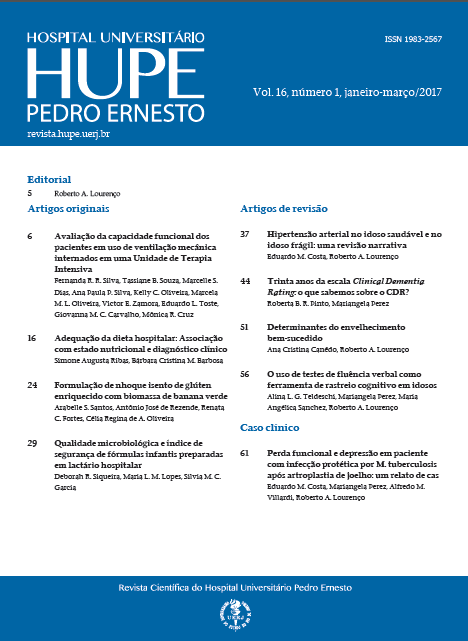Avaliação da capacidade funcional dos pacientes em uso de ventilação mecânica internados em uma Unidade de Terapia Intensiva
DOI:
https://doi.org/10.12957/rhupe.2017.33299Resumo
Introdução: Limitações físicas e psicológicas decorrentes do repouso prolongado no leito são complicações comumente encontradas no paciente crítico e impactam diretamente na capacidade funcional. Objetivos: Avaliar a evolução da capacidade funcional, da força muscular periférica e respiratória de pacientes ventilados mecanicamente internados no CTI Geral do Hospital Universitário Pedro Ernesto (HUPE). Metodologia: No período de dezembro de 2016 a fevereiro de 2017 observamos os pacientes admitidos no CTI. Pacientes que não evoluíram para ventilação mecânica (VM) foram excluídos. Os pacientes foram avaliados em quatro momentos: admissão no CTI geral (A1), primeiro dia de VM (A2), desmame da VM (A3) e alta do CTI (A4). Avaliamos a força muscular respiratória periférica, respiratória e a capacidade funcional através da escala PERME. Avaliamos a funcionalidade pré-internação hospitalar através do Índice de Katz no momento da admissão. Resultados: Foram incluídos 26 pacientes e 9 completaram as quatro avaliações. A mediana de idade foi de 63 (58 – 70) anos, SAPS III de 64 (44,75 – 68,50) e índice de Katz de 1 (0 - 1). Os valores do MRC, PImax e PEmax aumentaramprogressivamente. Os valores na escala Perme aumentaram de 2 (1,5-7,25) em A1 para 10 (6,75–22) em A4. Conclusão: A capacidade funcional, força muscular periférica e respiratória dos pacientes ventilados mecanicamente melhorou ao longo da internação no CTI Geral do HUPE. A escala Perme não foi aplicada em todos os momentos estipulados.
Descritores: Fisioterapia; Unidade de terapia intensiva; Cuidados críticos; Polineuropatias; Limitação da mobilidade; Força muscular.
Referências
Adler J, Malone D. Early Mobilization in the Intensive Care Unit: A Systematic Review. Cardiopulmonary Physical Therapy J. 2012. http://dx.doi.org/10.590/1809-2950/11511921042014
Murakami FM, Yamaguti WP, Onoue MA, et al. Evolução funcional de pacientes graves submetidos a um protocolo de reabilitação precoce. Revista Brasileira Terapia Intensiva. 2015. http://dx.doi.org/10.5935/0103-507X.20150028
Ferreira NA, Lopes AJ, Ferreira AS, et al. Determination of functional prognosis in hospitalized patients following an intensive care admission. World J Crit Care Med. 2016;5(4):219-27. http://10.5492/wjccm.v5.i4.219
Garnacho-Montero J, Amaya-Villar R, García-Garmendía JL, et al. Effect of critical illness polyneuropathy on the withdrawal from mechanical ventilation and the length of stay in septic patients. Critical Care Med. 2005;33(2):349-54.
Jonghe B, Lacherade J-C, Sharshar T, et al. Intensive care unit-acquired weakness: risk factors and prevention. Crit Care Med. 2009;37(10 Suppl):S309-315. http://10.1097/CCM.0b013e3181b6e64c
Hermans G, Van den Berghe G. Clinical review: intensive care unit acquired weakness. Crit Care Lond Engl. 2015;19:274. http://10.1186/s13054-015-0993-7
Van der Schaaf M, Dettling DS, Beelen A, et al. Poor functional status immediately after discharge from an intensive care unit. Disabil Rehabil. 2008;30(23):1812-8. http:// 10.1080/09638280701673559
Brower RG. Consequences of bed rest. Crit Care Med. 2009;37(10 Suppl):S422-428. http://10.1097/CCM.0b013e3181b6e30a
Green M, Marzano V, Leditschke IA, et al. Mobilization of intensive care patients: a multidisciplinary practical guide for clinicians. J Multidiscip Healthc. 2016;9:247-56. http://10.2147/JMDH.S99811
Castro-Avila AC, Serón P, Fan E, et al. Effect of Early Rehabilitation during Intensive Care Unit Stay on Functional Status: Systematic Review and Meta-Analysis. PloS One. 2015;10(7). http://10.1371/journal.pone.0130722
Denehy L, Morton NA, Skinner EH, et al. A physical function test for use in the intensive care unit: validity, responsiveness, and predictive utility of the physical function ICU test (scored). Phys Ther. 2013;93(12):1636-45. http://10.2522/ptj.20120310
Corner EJ, Wood H, Englebretsen C, et al. The Chelsea critical care physical assessment tool (CPAx): validation of an innovative new tool to measure physical morbidity in the general adult critical care population; an observational proof-of-concept pilot study. Physiotherapy. 2013;99(1):33-41. http://10.1016/j.physio.2012.01.003
Kawaguchi Y, Nawa RK, Figueiredo TB, et al. Perme Intensive Care Unit Mobility Score e ICU Mobility Scale: tradução e adaptação cultural para a língua portuguesa falada no Brasil. Jornal Brasileiro de Pneumologia. vol.42 no.6 São Paulo nov./dez. 2016;429-34. http://dx.doi.org/10.1590/s1806-37562015000000301
Kasotakis G, Schmidt U, Perry D, et al. The surgical intensive care unit optimal mobility score predicts mortality and length of stay. Crit Care Med. 2012;40(4):1122-8. http://10.1097/CCM.0b013e3182376e6d
Hodgson C, Needham D, Haines K, et al. Feasibility and inter-rater reliability of the ICU Mobility Scale. Heart Lung J Crit Care. 2014;43(1):19-24. http://10.1016/j.hrtlng.2013.11.003
Thrush A, Rozek M, Dekerlegand JL. The clinical utility of the functional status score for the intensive care unit (FSS-ICU) at a long-term acute care hospital: a prospective cohort study. Phys Ther. 2012;92(12):1536-45. http://10.2522/ptj.20110412
Perme C, Nawa RK, Winkelman C, et al. A Tool to Assess Mobility Status in Critically Ill Patients: The Perme Intensive Care Unit Mobility Score. Methodist DeBakey Cardiovasc J, 2014.
Soares M, Salluh JIF. Validation of the SAPS 3 admission prognostic model in patients with cancer in need of intensive care. Intensive Care Med. 2006;32(11):1839-44. http://10.1007/s00134-006-0374-4
Lino VTS, Pereira SRM, Camacho LAB, et al. Adaptação transcultural da Escala de Independência em Atividades da Vida Diária (Escala de Katz). Caderno de Saúde Pública, 2008.
http://dx.doi.org/10.1590/S0102-311X2008000100010
Duarte YAO, Andrade CL, Lebrão ML. O Índex de Katz na avaliação da funcionalidade dos idosos. Rev Esc Enferm USP, 2007.
Rodrigues ID, Barbosa L da S, Manetta JA, et. MUSCLE WEAKNESS ACQUIRED IN THE INTENSIVE CARE UNIT: A COHORT STUDY. Rev Atenção À Saúde Antiga Rev Bras Ciên Saúde, 2010. http://10.13037/rbcs.vol8n24.1052
American Thoracic Society/European Respiratory Society. ATS/ERS Statement on respiratory muscle testing. Am J Respir Crit Care Med. 2002;166(4):518-624. http://10.1164/rccm.166.4.518
Puthucheary ZA, Rawal J, McPhail M, et al. Acute skeletal muscle wasting in critical illness. JAMA. 2013;310(15):1591-600. http://10.1001/jama.2013.278481
Herridge MS, Tansey CM, Matté A, et al. Functional disability 5 years after acute respiratory distress syndrome. N Engl J Med. 2011;364(14):1293-304. http://10.1056/NEJMoa1011802
Burtin C, Clerckx B, Robbeets C, et al. Early exercise in critically ill patients enhances short-term functional recovery. Crit Care Med 2009;37(9):2499-505. http://10.1097/CCM.0b013e3181a38937
Pires-Neto RC, Lima NP, Cardim GM, et al. Early mobilization practice in a single Brazilian intensive care unit. J Crit Care. 2015. http://10.1016/j.jcrc.2015.05.004
Ntoumenopoulos G. Rehabilitation during mechanical ventilation: Review of the recent literature. Intensive Crit Care Nurs, 2015. http://10.1016/j.iccn.2015.02.001
Morris PE, Griffin L, Berry M, et al. Receiving Early Mobility During An ICU Admission Is A Predictor Of Improved Outcomes In Acute Respiratory Failure. Am J Med Sci. 2011. http://10.1097/MAJ.0b013e31820ab4f6


